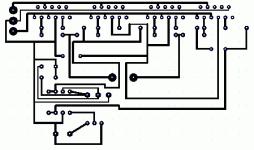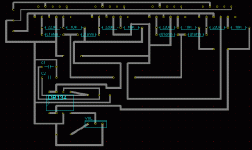I currently run a 10-inch subwoofer with one LM3886. Not too powerful, so I want to build something bigger. I looked at the Class D LM4651/2 from national, but it seems a little too complicates. Unless somebody has some pcbs using through hole components, I would like to stay away from something that complicated. I then found the Chainclone - http://www.euronet.nl/~mgw/diy/amps/uk_chainclone_1.html - and was wondering if anybody has used one of these before. If so, did anybody use it for a subwoofer? How does it sound? Is it better than the 4651/2?
Another idea I had was to build a stereo amp to drive my B&W DM580 speakers. If I am right, a bridged 3886 can do 220W into 8-ohm, so 440 into 4 and 880 into 2? My speakers are 8-ohm but 220W per channel is still pretty impressive. Or, since my speakers are 8-ohm, would I be better off just using 4 chips instead of 8 and not paralleling them? Can the 3886 drive a 4-ohm load in bridged mode at all?
Any ideas on the sub amp? Would it be worth it to just make a pcb and use the 4651/2?
Another idea I had was to build a stereo amp to drive my B&W DM580 speakers. If I am right, a bridged 3886 can do 220W into 8-ohm, so 440 into 4 and 880 into 2? My speakers are 8-ohm but 220W per channel is still pretty impressive. Or, since my speakers are 8-ohm, would I be better off just using 4 chips instead of 8 and not paralleling them? Can the 3886 drive a 4-ohm load in bridged mode at all?
Any ideas on the sub amp? Would it be worth it to just make a pcb and use the 4651/2?
I'm not familiar with the chainclone, so I can't comment there. As far as using 4 chips, you are going to have to parallel two pairs of them. You then bridge the two paralleled pairs. This will get you the bridged power you are looking for, and will also deliver plent of current to give you the low eon oomph we all love so much.
Cheers,
Zach
Cheers,
Zach
And almost 440W into my 4-ohm sub speaker?
If so, that has some good things. and some bad things. Good, thats a ton of power. Bad news, my subwooofer is a 100WRMS with a 300W handling. Is that too much?
Do I need a larger transformer to get 440W into 4-ohm than to get 220W into 8-ohm? Or would the one on that page work?
How do you bridge them together? Just connect the inputs together and use one output for one side of the speaker and the other for the other side?
If anybody has done this, does anybody have the pcb layout for one channel?
Thanks, Mike
If so, that has some good things. and some bad things. Good, thats a ton of power. Bad news, my subwooofer is a 100WRMS with a 300W handling. Is that too much?
Do I need a larger transformer to get 440W into 4-ohm than to get 220W into 8-ohm? Or would the one on that page work?
How do you bridge them together? Just connect the inputs together and use one output for one side of the speaker and the other for the other side?
If anybody has done this, does anybody have the pcb layout for one channel?
Thanks, Mike
Hi, you won't be able to double the power into a smaller load with this design, as the chips become limited by their maximum output current, and thermal dissipation, but you would probably still get around 300WPC, perhaps a little more, which is still quite a lot.
As far as these paticular circuits go, I'm not too sure how they would perform, as the are not totaly even in allrespects. Mainly, you have the inverting amp with Zin of around 1K Ohm, and the non-inveting with an input impedace about equal to that of the chip itself, which will be a lot higher.
Now, I have never built anything like this before, but I am guessig that as the input will drive the two halfs differently, you will have slightly different outputs on each half which could add a large amount of distortion, depending on how ideal your driver is.
As far as these paticular circuits go, I'm not too sure how they would perform, as the are not totaly even in allrespects. Mainly, you have the inverting amp with Zin of around 1K Ohm, and the non-inveting with an input impedace about equal to that of the chip itself, which will be a lot higher.
Now, I have never built anything like this before, but I am guessig that as the input will drive the two halfs differently, you will have slightly different outputs on each half which could add a large amount of distortion, depending on how ideal your driver is.
Would I be better off using the schematic from national's datasheet? If so, what is that opamp on the input for?
I would like the second one better since there is less parts, but on that one I really have no idea what that odd opamp is on the input.
heres the schematics:
http://www.diyaudio.com/forums/showthread.php?threadid=22305
I would like the second one better since there is less parts, but on that one I really have no idea what that odd opamp is on the input.
heres the schematics:
http://www.diyaudio.com/forums/showthread.php?threadid=22305
Hi, Jojo whent for the second schematic in the end, as it was easier to match everything up than the first one and he seemed to be haappy with it when he was finished.
As far as the op-amp thing at the front of the circuit, that is just a buffer, that will give you a non-inverted and an inverted output (ballanced), so that you can feed the out of phase signals to each half of the bridge when they are both either inverting or non-inverting designs.
As far as the op-amp thing at the front of the circuit, that is just a buffer, that will give you a non-inverted and an inverted output (ballanced), so that you can feed the out of phase signals to each half of the bridge when they are both either inverting or non-inverting designs.
The opamp at the beginning is just a buffer, and does just that, perhaps not crucial... but id say that would depend on whats driving it
Im personally about to embark on the circuit with the DRV134 at the input as (like bigparsnip says) id rather have each opamp running in the same mode to make it easier to match everything
Im personally about to embark on the circuit with the DRV134 at the input as (like bigparsnip says) id rather have each opamp running in the same mode to make it easier to match everything
First, what do you mean by snap?
second, can I just use a standard audio opamp at the input such as a 386? I am using a crossover based on the lm837 if that would do the same buffereing thing.
And yes, I think i will go with the second one also, it is less parts and less to explode when I short somethig out.
second, can I just use a standard audio opamp at the input such as a 386? I am using a crossover based on the lm837 if that would do the same buffereing thing.
And yes, I think i will go with the second one also, it is less parts and less to explode when I short somethig out.
PCB for LM3886
Going back to the original post, you can order a PBC for an LM3886 amp from www.marchandelec.com It's the PM21. There are two on the PCB and they can be bridged. You can also look at the schematic and construction guide there.
I think (but could be wrong) Marchand predates 47 Lab and most of the things that call themselves "gainclones".
However, I think it dubious that you can get the power levels you are looking for, especially with a 4-ohms load, out of any LM3886 amp. The reason is heat - the package isquite small which limits heat transfer. It might be OK for a subwoofer amp as those spend most of their time not doing much. I would be generous with the heatsinking and ventilation. Also I would select the non-encapsulated version and use the best rated (lowest thermal resistance) insulating pad I could find. On a posative note, the LM3886 has built in thermal protection so you could give it a try with a reasonable expectation you would not damage the chip.
Oh yes, I built the Marchand amp and found it easy to build and it sounds just fine comparred to your typical ChainStore amp. My personal bias is that no IC based amp (as yet) has the performance potential of a discrete amp. (Note I said potential - IC amps have the advantage of pretty clearly defined decent result where discrete designs run from incredibly bad to incredibly good)
Going back to the original post, you can order a PBC for an LM3886 amp from www.marchandelec.com It's the PM21. There are two on the PCB and they can be bridged. You can also look at the schematic and construction guide there.
I think (but could be wrong) Marchand predates 47 Lab and most of the things that call themselves "gainclones".
However, I think it dubious that you can get the power levels you are looking for, especially with a 4-ohms load, out of any LM3886 amp. The reason is heat - the package isquite small which limits heat transfer. It might be OK for a subwoofer amp as those spend most of their time not doing much. I would be generous with the heatsinking and ventilation. Also I would select the non-encapsulated version and use the best rated (lowest thermal resistance) insulating pad I could find. On a posative note, the LM3886 has built in thermal protection so you could give it a try with a reasonable expectation you would not damage the chip.
Oh yes, I built the Marchand amp and found it easy to build and it sounds just fine comparred to your typical ChainStore amp. My personal bias is that no IC based amp (as yet) has the performance potential of a discrete amp. (Note I said potential - IC amps have the advantage of pretty clearly defined decent result where discrete designs run from incredibly bad to incredibly good)
- Status
- This old topic is closed. If you want to reopen this topic, contact a moderator using the "Report Post" button.
- Home
- Amplifiers
- Chip Amps
- Chainclones - how do they sound

